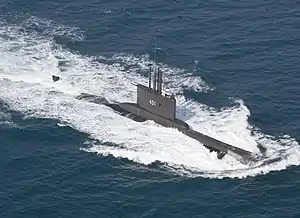Cakra-class submarine
The Cakra class, is a class consists of two Type 209/1300 attack submarine that were bought and commissioned by Indonesian Navy in the 1980s.
 KRI Cakra (401) | |
| Class overview | |
|---|---|
| Name: | Cakra class |
| Builders: | Howaldtswerke-Deutsche Werft |
| Operators: |
|
| Preceded by: | Whiskey class |
| Succeeded by: | Nagapasa class |
| Built: | 1977-1981 |
| In commission: | 1981–present |
| Completed: | 2 |
| Active: | 2 |
| General characteristics | |
| Type: | Attack submarine |
| Displacement: |
|
| Length: | 59.5 m (195 ft 3 in) |
| Beam: | 6.2 m (20 ft 4 in) |
| Draft: | 5.4 m (17 ft 9 in) |
| Propulsion: | |
| Speed: |
|
| Range: | 8,200 nmi (15,200 km; 9,400 mi) at 8 kn (15 km/h; 9.2 mph) |
| Endurance: | 50 days [1] |
| Test depth: | 240 m (790 ft) [1] |
| Complement: | 33 |
| Sensors and processing systems: |
|
| Electronic warfare & decoys: | ESM : Thomson-CSF DR2000U [1] |
| Armament: | |
Development
Cakra-class were ordered on 2 April 1977, designed by Ingenieurkontor, Lübeck for construction by Howaldtswerke, Kiel and sale by Ferrostaal, Essen-all acting as a consortium.[1] Both ships were laid down on 25 November 1977 and March 1978, respectively. They were completed on 18 March 1981 and 6 July 1981. There were plans to build two more boats of the same class but eventually nothing came out of it.[2]
On 25 September 1997, two ex-German Type 206 submarines were taken over with plans to refit them, followed by three others. Funds run out in June 1998 and the whole project was then cancelled. New plans to acquire submarine from South Korea were announced in October 2003. Then it all revealed that the intended procurement was an Improved Jang Bogo-class submarine which now were already in service as Nagapasa class.[1]
Design
The Cakra-class have high capacity batteries with GRP lead-acid cells and battery cooling supplied by Wilhelm Hagen AG.[1]
Operational history
In the 1999-2000 period, the relationship between Indonesia and Australia was reaching its highest tension due to Australian interference in the opinion polls which was held in East Timor. And one of the interesting story is that one of the transport ships that also served as a command ship for Australian Navy , HMAS Kanimbla, was in fact almost become a target of torpedo strike which would be launch from a Cakra-Class submarine.[3]
It was reported that when a Cakra-Class submarines was conducting a routine patrol duties in the Timor Sea, suddenly her sonar detected several unidentified surface ships moving towards Dili. As a follow-up, the submarine's commander slowly directed the ship to dive until reaching periscope depth. Later, several unidentified surface ships turned out to be a warship convoy, consists of three ships, an Australian Navy ship's HMAS Kanimbla which was escorted by two New Zealand Navy's frigates. These ships entered the Indonesian territorial waters without permission.[3]
Because it was considered violating the international law, the submarine immediately took action by preparing torpedoes to sink HMAS Kanimbla and her escort vessels. Both New Zealand Navy's frigates were aware of a presence of a sub, but the two frigates were unable to determine the exact position of the submarine. Then the commander of HMAS Kanimbla took quick response by establishing communication with the Australian government regarding the tense situation. After that, Canberra immediately took action by contacting Jakarta to "neutralize" the situation in the Timor Sea and requested permission to entering Indonesian waters and set sail to Dili for these three warships.[3]
After the problems at the top level were resolved, the submarine was ordered not to obstruct the convoy because there was already an official explanation from the Australian to Indonesian government. As ordered, the submarine then surfaced and continue to shadowed the convoy.[3]
List of boats
| Name | Hull number | Builder | Ordered | Laid down | Launched | Commissioned | Status |
|---|---|---|---|---|---|---|---|
| Cakra | 401 | Howaldtswerke | 2 April 1977 | 25 November 1977 | 10 September 1980 | 18 March 1981 | In active service [1][2] |
| Nanggala | 402 | Howaldtswerke | 2 April 1977 | March 1978 | 10 September 1980 | 6 July 1981 | In active service [1][2] |
Modernisation
Cakra-class undergo major refits at HDW spanning three years from 1986 to 1989, these refits were expensive and lengthy and may have discouraged further orders at that time. Cakra (401) refitted again at Surabaya from 1993 completing in April 1997, including replacement batteries and updated Sinbad TFCS. Nanggala (402) received a similar refit from October 1997 to mid-1999.[1]
Cakra began a refit again at Daewoo Shipyard, South Korea in 2004, which was completed in 2005. Work is reported to have included new batteries, overhaul of engines and modernisation of the combat system. A similar refit of Nanggala was completed in April 2006.[1]
References
- Saunders 2009, p. 353
- Gardiner & Chumbley 1995, p. 179
- Perdana, Gilang (26 April 2018). "Nyaris Disengat Torpedo Kapal Selam Cakra Class, Inilah Profil HMAS Kanimbla". indomiliter. Retrieved 23 September 2020.